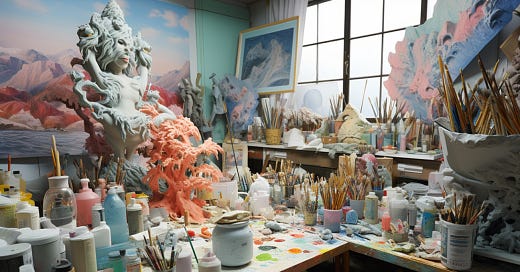004 - 04 - Human Flourishing & Creativity
The act of creation - a divinely inspired gift, or something more mundane?
Editors Note: This blog article is a summary of an in-person unconference event held in San Francisco on 2023-11-01, from a session moderated by Stephen Campbell
The integration of Artificial Intelligence (AI) into the domain of creativity and artistic expression stands as a profound turning point in the evolution of art itself. AI's capacity to accelerate skill acquisition in technical fields such as coding is undeniable. It introduces a new skill set—prompt engineering—that, while innovative, does not substitute for the nuanced mastery required in traditional disciplines. This dichotomy underscores the essential role human creativity plays in problem scoping and architectural design, areas where AI still trails behind the intuitive genius of the human mind.
Artistically, AI's ability to perceive beyond the human visual spectrum heralds new avenues for creative exploration. However, the quintessential challenge remains: AI's capacity to encapsulate the emotional essence of art lags, highlighting the need for advancements in multimodal AI technologies. This technological march forward blurs the lines between traditional expertise and artistic identity, democratizing creativity but simultaneously threatening the vocational pride of established artists. The rapid acquisition of skills through AI tools is unsettling in realms traditionally revered for the depth of human practice and dedication.
The emergence of AI-generated art invites a philosophical introspection into the value we ascribe to human intention, effort, and emotional connection in the face of technological output and impact. It raises the question: Can prompt engineers be considered true artists absent the years of vision and skill cultivation? Despite AI's ability to mimic stylistic elements, it lacks the emotional depth and personal narratives that human artists draw from their life experiences. The iterative, hands-on process of art creation—valued for its capacity to unlock deep emotional resonance—suffers when accelerated to AI speeds, leading to a homogenization of artistic voices and a diminution in the diversity of expression.
To navigate this new landscape ethically, there's a pressing need for mechanisms to distinguish AI-generated art, possibly through legal watermarking, to maintain transparency and authenticity. The potential for AI to become fully autonomous in learning and creation processes sparks existential inquiries about the nature of reality and truth in art, underscoring the necessity for initial oversight and control mechanisms to prevent AI from transcending our grasp.
The advent of personalized AI writing assistants and fine-tuning capabilities presents a promising frontier for individualized human-machine partnerships. These technologies allow for the generation of content that mirrors a person’s authentic voice and style, fostering opportunities for unique creative collaborations. However, this innovation walks hand in hand with privacy concerns and the potential for misuse, necessitating stringent standards around consent and data usage to protect individual privacy and integrity.
As we stand at the crossroads of human and machine creativity, the challenge lies in leveraging AI as a tool to augment rather than replace the human creative spirit. The ethical integration of AI in creative fields demands a judicious approach, ensuring that the technology serves to enhance rather than diminish the intrinsic value of human artistic endeavor.
In reflecting on the intersection of AI and creativity, the insights of social theorists such as Walter Benjamin, who explored the effects of mechanical reproduction on art, and Jürgen Habermas, with his discourse on the public sphere and rationality, offer valuable perspectives. Their works provide a framework for understanding the implications of technological advancements on human creativity, underscoring the need for critical engagement with these emerging tools to preserve the authenticity and diversity of artistic expression.




